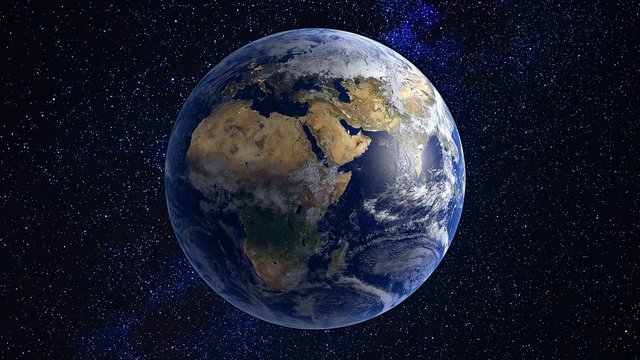Our Solar System - Earth #2

But why the earth carries so much water, significantly more than any other planet in our solar system, has not yet been explained. It is likely that asteroid impacts left water on the earth in early times.
The earth's orbit is not an exact circular orbit, but an ellipse, i.e. the distance to the sun is only 150 million kilometers on average, but it actually moves between 147 and 152 million kilometers away from the sun.
Is that the cause of the seasons? No, the reason is different. If you take earth and sun center, you get a line that goes through a plane. This plane is called ecliptic. The earth's axis is not perpendicular to this plane, but is inclined against it, at 23.44 degrees, which is called the skewness of the ecliptic.
The globe is inclined in space. In the winter of our northern hemisphere, the earth is closest to the sun, but the northern hemisphere is turned away from the sun because the earth is tilted, so less sunlight reaches the northern hemisphere. In summer it is the other way round, then the north is inclined towards the sun and receives more light.
In both hemispheres some auroras are formed and they are formed when electrically charged particles of the solar wind from the magnetosphere, which mainly consist of electrons but also protons, meet oxygen and nitrogen atoms in the upper layers of the earth's atmosphere and ionize them. When recombination takes place again after a short time, light is emitted. Due to the energy transfer, the electrons slip one shell to the outside, but then back to the original shell if the Bohr atomic model is taken as the basis. Electromagnetic radiation is emitted and light is emitted. This is the reason for polar lights, called Aurora borealis in the northern hemisphere and Aurora australis in the southern hemisphere.
The energy balance of the earth is essentially determined by solar radiation. The ratio of irradiated to reflected energy is called the Albedo. The earth has an Albedo of 0.367, i.e. 36.7 percent of the irradiated sunlight is reflected, the rest is swallowed by the earth's atmosphere, the oceans and the continents.
Venus has an Albedo of 0,12 so 88 percent of the sunlight is captured by the planet.

 Part 1
Part 1 


NASA - Space.com
Space Facts - Nine Planets
Lumen Learning
NorthernLights Centre - Aurora Service
Images: 1

@oendertuerk another very interested post on the universe , I am brushing up my knowledge.
I am @themarkymark
@oendertuerk I kindly ask from the steemleo community not to abuse the #steemleo tag as we will take action by downvoting.
@jankos55 sry for using and spamming the #steemleo tag, i didn'tknow that it is only for investors.
It's ok. We all want to keep our blogs reputable and friendly :)
Hi, @oendertuerk!
You just got a 1.26% upvote from SteemPlus!
To get higher upvotes, earn more SteemPlus Points (SPP). On your Steemit wallet, check your SPP balance and click on "How to earn SPP?" to find out all the ways to earn.
If you're not using SteemPlus yet, please check our last posts in here to see the many ways in which SteemPlus can improve your Steem experience on Steemit and Busy.
Thank you very much for giving us the basics of earth where we all lives, there is shortage of water. I want the earth water to reach there also so that we can also getting for our thirst.
But in the actual sense, I got a lot of knowledge by reading your post keep posting such interesting post.
Congratulations @oendertuerk!
Your post was mentioned in the Steem Hit Parade in the following category:
I am learning some interesting things by reading your posts, thanks for sharing! I imagine that Earth's albedo is closely related to the ozone layer, and as such, is decaying, right?
Posted using Partiko Android
informative. well written. thank you..
Hi @oendertuerk!
Your post was upvoted by @steem-ua, new Steem dApp, using UserAuthority for algorithmic post curation!
Your UA account score is currently 4.964 which ranks you at #1165 across all Steem accounts.
Your rank has improved 2 places in the last three days (old rank 1167).
In our last Algorithmic Curation Round, consisting of 166 contributions, your post is ranked at #28.
Evaluation of your UA score:
Feel free to join our @steem-ua Discord server